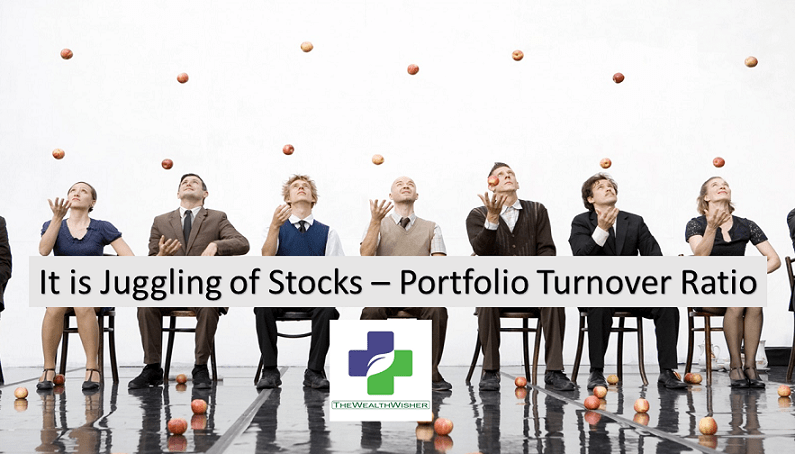When you build a portfolio, one of the most important ratios to check out is the Portfolio Turnover Ratio. The mutual funds especially the active ones, the fund managers keep buying and selling the stocks. This buying and selling activity is recorded and hence this ratio is calculated. We shall see how Portfolio Turnover Ratio is calculated, what is the significance and does it improves fund performance or vice versa?
What is Portfolio Turnover Ratio?
Portfolio Turnover Ratio is the percentage of a fund’s holdings that have changed in a given year. This ratio measures the fund’s trading activity.
So if for a Fund X with yearly average AUM of 100 Cr, if the fund manager bought 20 Cr of assets and sold 30 Cr of an asset in the given month year, portfolio turnover ratio will be:
PORTFOLIO TURNOVER RATIO = 20/100
= 0.2 or 20%
Portfolio turnover is calculated by taking either the total amount of new securities purchased or the amount of securities sold, whichever is less over a particular period, divided by the total net asset value (NAV) of the fund. This is the method used globally.
Let us look the Portfolio Turnover Ratio for our Indian Mutual Funds:
Top PORTFOLIO TURNOVER RATIO for Large Cap Funds

Top PORTFOLIO TURNOVER RATIO for Mid Cap Funds

What if PORTFOLIO TURNOVER RATIO is greater than 100%
Last week I received this email from one of the investors…

Does portfolio turnover over 100% means the fund is speculative? Is he not convinced of his holdings?
No, a turnover ratio of 100% or more does not necessarily suggest that all securities in the portfolio have been traded. This can be explained as this:
- Suppose there is a fund of 100 Cr. It has 10 Securities worth 10 Cr each. I am simplifying the figures so that you understand this in a lucid way.
- Now, first 6 shares or securities are core securities and fund manager is comfortable to “buy and sit tight” on these. So 60 % of the portfolio is not churned.
- Remain 4 stocks worth 40 cr or 40% was bought and sold at the discretion of the fund manager. They were not only sold at a high price and they were again bought when prices went down.
- Also, few of them were sold and new shares were brought in.
- So this 40% portfolio was sold 3 times. Hence the portfolio turnover ratio was 120%. But 60% of the portfolio never left the portfolio.
Significance of Portfolio Turnover Ratio
- If the portfolio is churned many times during a year, the fund will incur higher transaction costs.

- Aggressively managed funds generally have higher portfolio turnover rates than conservative
A low turnover figure (30% to 50%) would indicate a buy-and-hold strategy. - Use Portfolio Turnover Ratio in conjunction with other ratios and parameters to evaluate mutual fund schemes.
Taxation
If you buy and sell shares or MFs in less than 365 days you would have paid a Short Term Capital Gain Tax of 15% plus surcharges.
But this Short Term Capital Gain is not applicable on Fund or Fund Manager. This is because:
- The shares/securities held by the fund is of unit holders and not of the fund.
- The MFs are a just mere trustee of the securities. The ownership belongs to unitholders. So they will pay tax when they sell units.
Uses of Portfolio Turnover Ratio
PORTFOLIO TURNOVER RATIO can be used in following ways:
- Comparing PORTFOLIO TURNOVER RATIO of same peer group funds speaks about how a fund is managed. Look above in the same category Large Cap, ICICI Pru Focussed Bluechip Fund has provided better returns than say Taurus Bonanza.
- It speaks about the fund manager or fund house philosophy to churn the portfolios. DSP Blackrock & ICICI Pru Mutual Funds churn aggressively and generate better returns. Same way Motilal Oswal MF & Franklin Templeton MF believes in low churning and “buy & sit tight” philosophy. They too generate good returns.
- Funds that have a dynamic asset allocation based on market valuations, too, may see a higher portfolio turnover.
- Funds with small corpus can have huge portfolio turnover ratio.
Many of the rating agencies like Morningstar or Valueresearch do not include Portfolio Turnover Ratio in their rating methodology or calculations. Investor or his advisor is left to check and draw inferences from this ratio.
Share your views in the comments section below and also share this article with your family & friends to benefit all.










